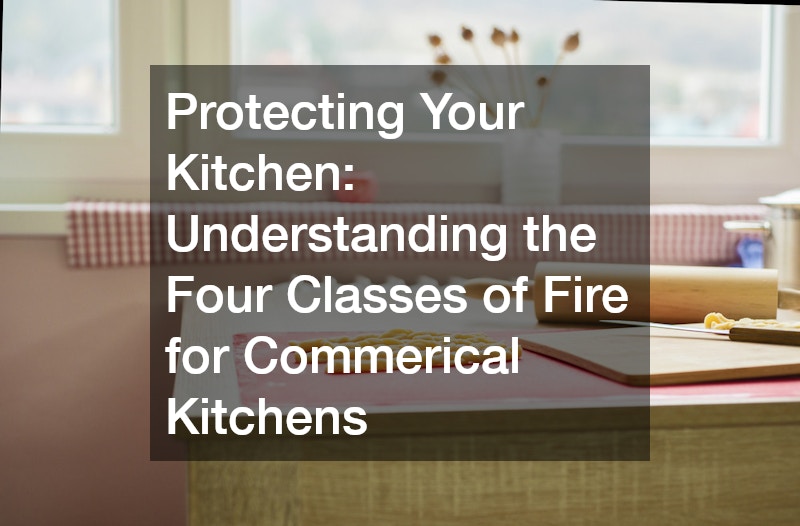
Protecting Your Kitchen Understanding the Four Classes of Fire for Commerical Kitchens

If you’re a business owner, you’ll want to take necessary precautions to help protect your place of business. One important danger to consider is fires. All companies need smoke detectors and fire extinguishers. Firms with a kitchen must have an additional protective measure: a fire sprinkler plan. Fire protection is an essential section of your business’ Safety Plan.
When you first construct your kitchen, the fire sprinkler system design should be based on several factors. According to the (NFPA) National Fire Protection Agency, the fire sprinkler design should be based on the ceiling height, the amount of water available in your kitchen, and how many workers will be in the kitchen most of the time. If you have any questions about fire sprinklers, a fire sprinkler designer can review fire sprinkler calculations with you.
The calculations used to determine these fire sprinkler guidelines are based on NFPA guidelines. The NFPA has been considered the national authority on fire protection for over 125 years. The principles of fire protection system design are based on scientific principles of fire protection engineering. Their investigations of building material flammability and post-fire analysis are influential in designing new types of fire sprinkler systems.

As someone who works in a commercial kitchen, the threat of a kitchen fire breaking out is a very real one that occurs over 8,000 times per year. Aside from the possible loss of life and injury, kitchen fires are absolutely devastating for businesses, costing an annual average of $246 million in direct property damage. Understanding the potential for fire, as well as how to prevent and fight different kinds of kitchen fires could be the difference between life and death.
Class A Fires
Your Class A fires are perhaps the ones that people are most familiar with. These fires consist of ordinary combustibles such as wood, trash, paper, or anything else that leaves ash behind. Likewise, as many people would expect, water is the best combatant to douse and extinguish Class A fires. In order to prevent the possibility of Class A fires, employees ought to be sure to remove the ashes from wood and charcoal burning ovens on a daily basis and store them in outside containers at least 10 feet away from buildings and combustibles.
Class B Fires
Class B fires are an entirely different beast from Class A fires. A Class B fire is one that is fueled by a flammable or combustible liquid including oil, gasoline, and similar materials. Water proves to be an ineffective solution to Class B fires, as it is likely to only spread the flames along. Instead, fire extinguishers that aim to smother the fire and deplete it of oxygen are the best when it comes to Class B fires. Iould be wise to have regular fire extinguisher servicing done to ensure that kitchens are protected in the event of a Class B fire.

Class C Fires
Class C fires can be particularly dangerous and unpredictable as they are energized electrical fires. Where there are wires and outlets, there can be a Class C fire. In order to effectively extinguish a Class C fire, always be sure to first de-energize the circuit by tripping the breaker before using a non-conductive extinguishing agent; fire extinguisher services typically denote the effectiveness of an extinguisher against different classes of fires. A fire extinguisher recharge can extend the service life of an extinguisher, plus it can give the option of adding a carbon dioxide charge specially suited for Class C fire combat.
Class K Fires
As a restaurant employee, you will be most likely to encounter Class K fires; the K stands for “kitchen”! Class K fires are those that involve cooking oils, grease, or animal fat; these fires react violently against water and must be extinguished properly before they spread. The best combatant for a kitchen fire is Purple K, the agent that is typically found in kitchen or galley extinguishers. Due to the fact that around 57% of restaurant fires involve cooking equipment, managers and supervisors should ensure that employees know where fire extinguishers are located and which are suitable to combat certain fires.
Keeping Up With Your Fire Extinguisher Services
Fire extinguisher services should be contacted regularly to ensure that all fire extinguishers are up to code and functioning properly. With regularly scheduled fire extinguisher inspections, kitchen managers have avoided potentially costly errors that could have resulted in the loss of an entire kitchen should the extinguishers have failed. The actual automatic extinguishing systems installed in commercial kitchens should be inspected and serviced every six months by certified fire extinguisher services. Contact a certified extinguisher service in your area to ensure that your kitchen is prepared for the unexpected.